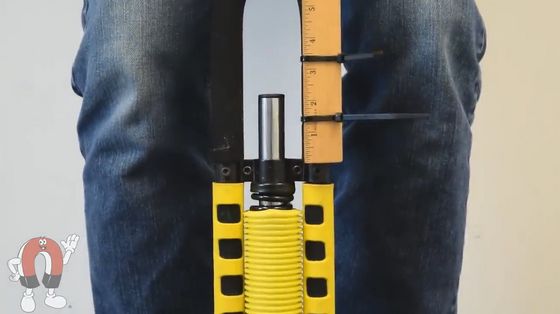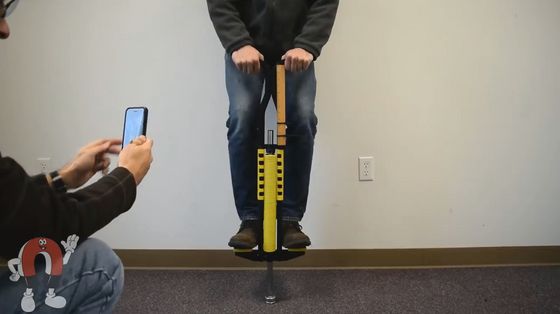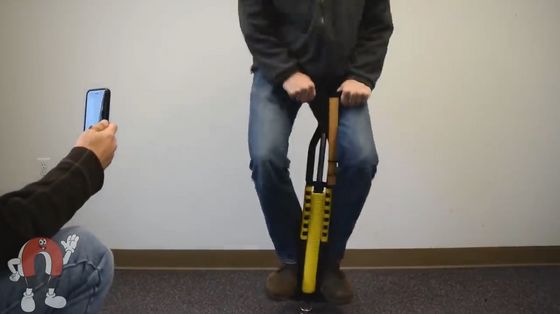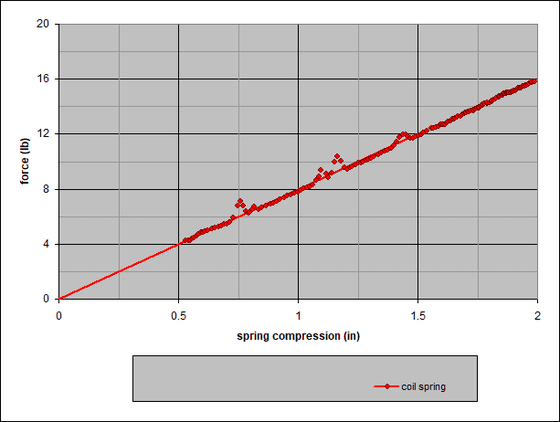Is it possible to replace the 'hopping spring' with a magnet?

The team of K & J Magnetics, Inc , which sells powerful neodymium magnets, was told by the user that he was inquired of "Can you replace the spring by using the repulsion of the magnet?" So, the development team actually analyzed the hopping spring and carried out the experiment "Can you replace the hopping spring with a magnet?"
Magnetic Pogo Stick
https://www.kjmagnetics.com/blog.asp?p=pogo-stick-spring
The team seems to have performed various verifications using old hopping, and a movie that summarizes the appearance is released on YouTube.
Magnetic Pogo Stick?
Hopping that jumps with Pyeongyeong with one leg has springs to absorb the impact and jump. The verification team attached a ruler to hopping and measured how much the spring would be compressed when an adult man of 150 pounds (about 68 kg) weight used hopping. First of all, when an adult male deposited his entire weight in hopping, the spring shrank about 2 inches (about 5 cm).

Next, from the state of weight being applied normally ......

Compressive compression with momentum.

I was able to push the hopping to the limit almost.

In this state, the spring seems to have been pushed in about 7 inches (about 18 cm), and the load on the spring actually exceeds 500 pounds (about 230 kg).

In order to test whether the spring can be replaced by a magnet, the verification team decided to support the weight of a 68 kg adult male using a ring-shaped neodymium magnet " RYO 46 " having a diameter of about 2 inches. Pass RYO 46 through each rod four times to repel each other and create a state in which the top plate floats. If you put your weight on it slowly ... ...

I was able to keep the floating state without magnet sticking even when applying the whole weight. Even if you step on with a little momentum, the magnets will not collide ... ...

The space was delicately empty.

However, as I jumped vigorously, I could not withstand just the repulsive force of the magnet, and the magnets collided with each other.

Unfortunately, based on the judgment that "it is dangerous to use a considerably powerful magnet in a large amount when trying to replace the full-size hopping spring with a magnet", this time we will use miniature hopping on 1/8 scale I decided to use.

In order to investigate whether or not the spring can be replaced by a magnet, we first need to understand Hooke's law that "the force applied to the spring is proportional to the distance by which the spring stretches or shrinks." The " spring constant " of the spring used by the validation team this time is 8 lbs (about 3.6 kg) per 1 inch (about 2.5 cm). That is, the force applied to the spring when the spring is contracted 2 inches is 2 x 8 = 16 pounds (about 7.2 kg), and the force applied when the spring is contracted 0.5 inch (about 1.3 cm) is 0.5 x 8 = 4 It will be pounds (about 1.8 kg).

Also, in the case of hopping, the spring is slightly shrunk at the first stage. To reproduce it, the verification team originally set the miniature hopping with the spring of about 2.9 inches (about 7.4 cm) shortened to 2.4 inches (about 6 cm) in length.

As a result, before the force is applied to the hopping itself, a certain amount of force is applied to the spring. It is like this when it is graph.

To investigate whether miniature hopping springs could be replaced by magnets, the team set two ring-shaped neodymium magnets with a diameter of 0.75 inches ( RC 44 ) in miniature hopping with the magnets repelling each other .

As a result, it showed the relationship between the distance shrunk miniature hopping and the applied force in a graph. The red line represents the spring, and the blue line represents the magnet. The magnet hardly resisted even when pushing in the hopping, and finally strongly repelled after pushing in about 1.5 inches (about 3.8 cm). The spring draws a very steep curve with the magnet, whereas the applied force and the shrunken distance draw a linear graph, whereas the magnet draws a very steep curve.

Subsequently, the verification team increased the number of magnets to three.

The pink line represents 3 magnets. It is getting closer to the red line little by little, and this approach seems to be correct.

Further verify by increasing the number of magnets to 4.

Although it is getting close to the line graph of the spring, you can see that the moving distance to the applied force is longer than the spring in all areas. Also, there was a problem that increasing the number of magnets reduces the physical mobility of hopping. When the four magnets were piled up, the length of the magnet that was completely contracted became equal to the length of the spring that completely contracted.

Increasing the number of magnets to 5 ... ...

The limit distance at which hopping shrinks is about 1.25 inches (about 3.1 cm). Even this still the movement distance to the applied force is still longer than the spring.

Finally, I increased the number of magnets to six. Because of the structure of hopping, it is very difficult to put more magnets.

Then, it was finally a zone but a zone with stronger repulsive force than the spring appeared.

From the above experiments, it is considered difficult to replace the repulsive force of the spring with the repulsive force of the magnet, since there is a big difference between the behavior of the spring and the behavior of the magnet . Of course, depending on the application, the verification team concluded that attempts to replace at least the hopping spring with a magnet would not work.
Related Posts:







